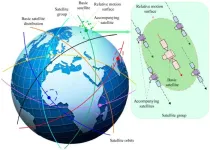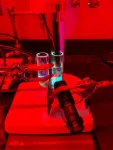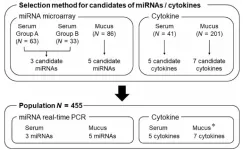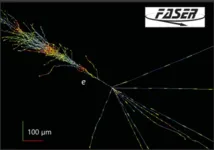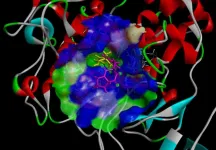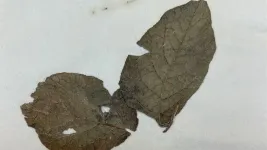Ben-Gurion University scientist uses state-of-the-art microscopy to discover drug candidates for cancer
Reveals structural basis of how cells use iron
2024-08-05
(Press-News.org)
BEER-SHEVA, Israel, August 5, 2024 – Microscopy has been making leaps and bounds in recent years. Science that was inconceivable a few years ago has become a matter of programming state-of-the-art microscopes to process reams of data. Dr. Gabriel Frank quickly realized the potential of cryo-electron microscopy to discover the molecular structures at levels heretofore unobservable. When he joined Ben-Gurion University of the Negev, he pushed for the University to enter the field, culminating in the establishment of the Guzik Center for Advanced Microscopy and the purchase of a new more advanced electron microscope. Using this microscope, Dr. Frank discovers promising drug candidates for cancer – the disease widely and rightfully referred to as "The emperor of all maladies," a phrase coined by to by Dr. Siddhartha Mukherjee.
Dr. Frank’s latest research, published in Nature Communications (https://doi.org/10.1038/s41467-024-48151-1), which is the first with BGU’s more advanced cryo-electron microscope, explicates the interactions of ferritin with its regulator Nuclear Receptor Coactivator 4 (NCOA4). In the cell ferritin acts as a cage for iron ions. NCOA4 is used by the cell to decide when to release them from the cage and when to store them. Too much iron in the cell is toxic and leads to its death. Too little and the cell slows it down until all its processes are brought to a halt including cell replication, which is crucial for cancer progression.
Using the cryo-electron microscope, Dr. Frank and his students were able to see for the first time the atomic details of the interaction between NCOA4 and ferritin. Understanding how NCOA4 binds ferritin could potentially pave the way for the synthesis of drugs that block this interaction, thus slowing down aggressive cancer cells, which strongly depend on large amounts of free iron.
In addition to his own research, Dr. Frank is passionate about the potential of cryo-electron microscopy and advancing it in Israel. To that end, he runs courses for students and faculty from other universities on BGU’s microscope.
This research was supported by NSF-BSF collaborative grant 2231900 2022614, the Israel Science Foundation (Grant no 364/20), NIH grant R01 DK124384 and the Morris Family Pancreatic Cancer Research Fund. The researchers also thank the Guzik Foundation for its support of BGU’s Cryo-electron microscopy unit.
END
ELSE PRESS RELEASES FROM THIS DATE:
2024-08-05
First, satellites in the mega constellation are categorized and the constellation design based on different satellite division is proposed. Satellites in the mega constellation are divided into 2 types, namely, the basic satellites and the accompanying satellites. All basic satellites that are surrounded by accompanying satellites are evenly distributed globally, and they have the same subsatellite trajectory. A basic satellite and its accompanying satellites are defined as a satellite group. The constellation is composed ...
2024-08-05
If somebody complains that it hurts to think, they may be onto something, as mental exertion appears to be associated with unpleasant feelings in many situations, according to research published by the American Psychological Association.
“Managers often encourage employees, and teachers often encourage students, to exert mental effort. On the surface, this seems to work well: Employees and students do often opt for mentally challenging activities,” said senior author Erik Bijleveld, PhD, of Radboud University. “From this, you may be tempted to conclude that ...
2024-08-05
Drylands, found across every continent, cover about 45% of the Earth's land surface and support 38% of the human population. In these regions, precipitation is low and evaporation rates are typically high, leading to an arid or semi-arid climate. Due to scarce water resources and sparse vegetation, drylands present formidable challenges for agriculture and human habitation. As the climate continues to warm, drylands are rapidly expanding.
A particularly urgent problem in drylands is climate-driven soil degradation, which affects about 33% of the planet’s land surface.
Drylands host ...
2024-08-05
Dartmouth researchers have developed a self-powered pump that uses natural light and chemistry to target and remove specific water pollutants, according to a new report in the journal Science.
As water enters the pump, a wavelength of light activates a synthetic molecular receptor designed to bond to negatively charged ions, or anions, a class of pollutants linked to metabolic disruptions in plants and animals. A second wavelength deactivates the receptors as water exits the pump and causes them to release the ...
2024-08-05
The method used across the United States to wait-list children for heart transplants does not consistently rank the sickest patients first, according to a new study led by Stanford Medicine experts.
The study will publish online Aug. 5 in the Journal of the American College of Cardiology.
Adding nuance to the wait-list system by accounting for more health factors could reduce children’s risk of dying while they await donor hearts, according to the study’s authors. A revision to the way donor hearts are assigned is already in process. The study adds evidence for why it is needed, they ...
2024-08-05
Cervical cancer is a highly prevalent cancer, with approximately 500,000 new cases diagnosed each year. Shockingly, the number of individuals diagnosed with precursor lesions in the cervix—also known as cervical intraepithelial neoplasia (CIN)—is 20 times higher. As with many potentially malignant conditions, early diagnosis of cervical cancer can make all the difference in a patient’s life in terms of treatment outcomes. For this, developing effective, convenient, and easily available screening protocols for CIN and cervical cancer is of paramount importance.
Currently, the two ...
2024-08-05
Neutrinos are fundamental particles in the Standard Model of particle physics, notable for their extremely small masses and weak interactions with matter. They are important for answering fundamental questions about the universe, including why particles have mass and why there is more matter than antimatter. Despite being abundant, their weak interactions make their detection difficult, and hence they are called “ghost particles.” At any given moment, numerous neutrinos freely pass through the Earth and our bodies, which originate from the Sun or cosmic rays. Understanding their rare interactions with matter is crucial for obtaining a more complete picture ...
2024-08-05
Melanin protects the skin—the body's largest organ and a vital component of the immune system—from the damaging effects of ultraviolet (UV) radiation. When the skin is exposed to UV radiation, melanin production is stimulated in melanocytes, with tyrosinase playing a key role in the biosynthetic pathway. However, disruptions in this pathway caused by UV exposure or aging can lead to excess melanin accumulation, resulting in hyperpigmentation. To address this, tyrosinase inhibitors that suppress melanin synthesis have become valuable in the cosmetic industry. Unfortunately, some of these compounds, ...
2024-08-05
In an examination of the genetic material found in historic potato leaves, North Carolina State University researchers reveal more about the tit-for-tat evolutionary changes occurring in both potato plants and the pathogen that caused the 1840s Irish potato famine.
The study used a targeted enrichment sequencing approach to simultaneously examine both the plant’s resistance genes and the pathogen’s effector genes – genes that help it infect hosts – in a first-of-its-kind analysis.
“We use small pieces of historic leaves with the pathogen ...
2024-08-05
Caltech researchers have developed a new method to measure soil moisture in the shallow subterranean region between the surface and underground aquifers. This region, called the vadose zone, is crucial for plants and crops to obtain water through their roots. However, measuring how this underground moisture fluctuates over time and between geographical regions has traditionally relied on satellite imaging, which only gives low-resolution averages and cannot penetrate below the surface. Additionally, moisture within the vadose zone changes rapidly—a thunderstorm can saturate a region that dries ...
LAST 30 PRESS RELEASES:
[Press-News.org] Ben-Gurion University scientist uses state-of-the-art microscopy to discover drug candidates for cancer
Reveals structural basis of how cells use iron
